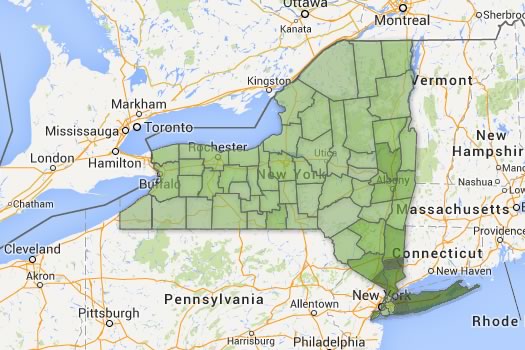Household income and poverty rates in New York State -- and how Saratoga is different from the rest of the Capital Region

Estimated household income by county. Don't squint -- there are better maps after the jump.
Map(s) of the day: New York State counties by median household income and percent of people living in poverty.
The Census Bureau released new income and poverty estimates -- for the year 2012 -- this month. So we put together maps of New York State based on the data.
Three large-format, clickable maps are post jump -- along with a few observations.
The maps are above in large format -- click or scroll all the way up.
A few notes and observations
+ Not surprisingly, the downstate counties lean very much toward the upper end for household income. Putnam County in the Hudson Valley topped the list at 92,950, followed by the two Long Island counties -- Nassau (92,543) and Suffolk (85,717), Rockland (81,517), and Westchester (77,166).
+ But downstate also has the county with the lowest median household income -- the Bronx, at 32,510. Also near the bottom: Kings County (Brooklyn) at 44,850.
+ Capital Region core median household income: Saratoga - 66,677; Rensselaer - 59,237; Albany - 57,951; Schenectady - 54,654.
+ Capital Region core poverty estimates (percent all ages/ percent children): Albany - 13.8/16.7; Schenectady - 12.4/20.1; Rensselaer - 11.6/16.7; Saratoga - 6.6/8.9.
+ Viewed in a certain way, Saratoga County is more like the NYC suburbs than its upstate neighbors. Its median household income is 8th highest in the state (just behind Manhattan). But what really sets it apart from the upstate crowd: its relatively low poverty rates -- at least half of the Capital Region's other three core counties.
+ The numbers for Montgomery County -- which is just the west of Schenectady County -- caught our eye. Its median household income estimate as second-lowest in the state, at 41,034. And 19.6 percent of residents were estimated to be in poverty -- and almost 31 percent of its kids.
+ The disparity between the upper and lower end of the county median household income chart is striking. The median household income in Putnam County is almost three times higher than that of the Bronx. Or even compare it to Albany County, which is 12th highest in the state -- Putnam's median household income is still 1.6 times that of Albany County.
All counties
Elsewhere
Last week The Atlantic put together a national look at this same data.
Hi there. Comments have been closed for this item. Still have something to say? Contact us.
Comments
Very interesting. I wonder why there are so few poor people in Saratoga. Why are they concentrated in Albany, Schenectady, and Troy? Is it because Saratoga is a resort town? Are there fewer amenities for them, less section 8 housing?
... said Jason on Dec 16, 2013 at 8:31 PM | link
@Jason: That's a good question. Putnam County and the Long Island counties also have low percentages of people in poverty. But other high median income counties -- such as Westchester and Rockland -- do not.
... said Greg on Dec 17, 2013 at 11:48 AM | link
16.7 percent of children living in poverty in Rensselaer County is a very sobering statistic. Can I assume that the poverty rate in the City of Troy is higher?
... said Kathleen Lisson on Dec 17, 2013 at 2:06 PM | link
The reason there are so few poor people in Saratoga County, is because there are almost no bus routes. You either have to live within walking distance, or have a car to get around Saratoga County.
The areas with the highest density of poor people are the west side of Saratoga Springs (has a bus route) and the Rte 9 corridor at Exit 9 in Clifton Park.
... said dgc on Dec 17, 2013 at 3:20 PM | link
I think you need a lot more info to establish the reasons the income/poverty levels are what they are. # of two parent households, Level of education, non-owner occupied homes etc.
Is there somewhere to get this info for a period of say 20-30 years? It would be interesting to see if there are any changes based upon which party's are in control. We are told so often that Dems favor the poor and Repubs favor the wealthy. If these stats were consistent over the last 30 years it would challenge that theory..IMHO.
... said Needmoregellin on Dec 17, 2013 at 11:21 PM | link
What we should expect to see is more movement of folks in poverty to traditionally suburban neighborhoods as city development projects begin to reverse, "suburbanization." I for one am interested to see what happens as folks in need move into spaces which lack comprehensive public transportation. The majority of resources for these households have been built up around city centers. Much like the rural poor, we should expect to see more families "stranded" as they search out cheaper homes and apartments, and yet are removed from other resources that they need. This could have a significant impact on a county like Saratoga-a county which does not even have an emergency shelter for the homeless.
... said GD on Dec 18, 2013 at 3:50 PM | link